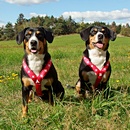
Treibball Challenge, Autumn 2016 - Spring 2017
During autumn 2016 - spring 2017, we completed successfully the German online treibball course named Uzraubsziele - Treibball
Challenge by Anja Jakob. As the name Urlaubsziele suggests, in the course we visited some of the famous vacation
destinations. During performing various tasks, we returned to the places we had already visited during our vacations
(USA, Spain, Greece, Austria and Switzerland). The course was attended by 25 treibball teams of different levels, we
signed for the highest TRB 3 class. In each country, we had to accomplish several tasks according to the assignment
(description, picture, instructional videos differentiated for different levels, for more difficult tasks also the
“how to do” videos). All the participants had to document fulfilling of different tasks in the form of videos. We had
the opportunity to see videos of all other participants and there was a rich and very productive discussion in the group.
The assignments were very creative and Anja introduced us during the course the treibball in all its diversity and richness.
From a straight playground, we went to the rugged terrain and the inclusion of work with many different elements expanded
our treibball borders, but this was the area where we had the biggest weaknesses and we had to work hard. During the course,
the distant control of both our females has greatly improved, the treibball has become more interesting for us and we have
met many treibball friends abroad.
The first visited country was the USA. After a precise positioning on the Star of the Walk of Fame, a "free discipline"
followed, where dogs had to demonstrate the ability to work with balls not only on a flat playground, but also on the
more difficult, rugged terrain reminding of the Grand Canyon.
The second visited country was Spain. The first task was the Paella
prepared from the specified assortment of elements.
The basic principle was the same for all performance classes, the number of elements and the size of the
circle varied by class. As a spice, everyone should use the elements of other dog sports. The second task was the
bullfight according to the instructional video. The task was again the same for all classes, the number of balls
and distance varied.
The third visited country was Greece. The two Kyklades "sailings",
where the movement between targets and balls was precisely prescribed, in class 3 for a long distance, was a hard job
for us. Since we have worked mainly with balls in the past, we had to “demagnetize” them. In addition, it was necessary
to work slowly and calmly, which was far from easy for our temperament girls. After managing this task, however, their
remote control has dramatically improved.
The fourth theme was skiing in the Austrian Alps. The first task was slalom of varying difficulty according to the
chosen class. In slalom, the orientation of the dog handler on the track and his ability to navigate the dog in the
best way were very important. While Milan and Bara managed the task easily, I was very limited by my poor spatial
orientation and sometimes I was rather an obstacle than help for Aisha which resulted in parallel slalom. The second
task was devoted to snowmen like fun after skiing.
After the originally announced four destinations, the fifth (bonus) destination Switzerland was added. The theme was
a daily care for cattle. This way our two Swiss cattle dogs returned to their homeland and to their natural work with
cows. The first task was to drive the cows out in a certain order, and it was possible to choose whether they would
be driven from the stables (boxes) or from the open space. To accomplish the first task, we used the elements of our
preparation for races in Pesopark. Fulfilling the second task – taking care for the herd and going around it from left
/ right was harder for us and it took us a long time, because our original navigation was not sufficient for the long
distance and we had to change it. The last task - finding hidden cows and bringing them home was once again easier for
us thanks to regularly bringing the balls occasionally hidden in the shrubs by wind.




